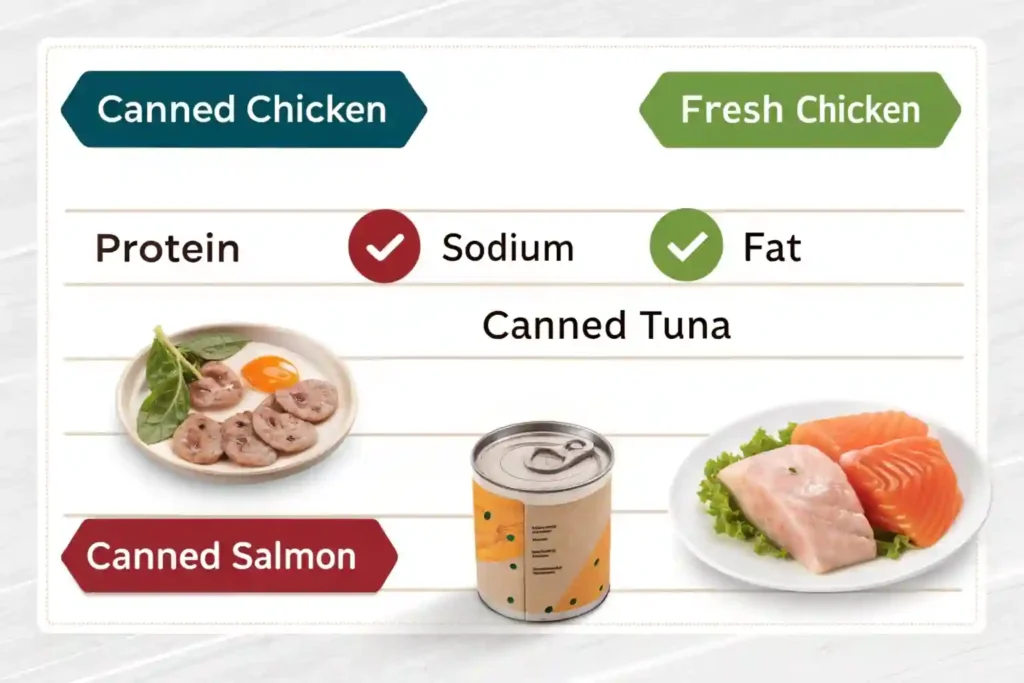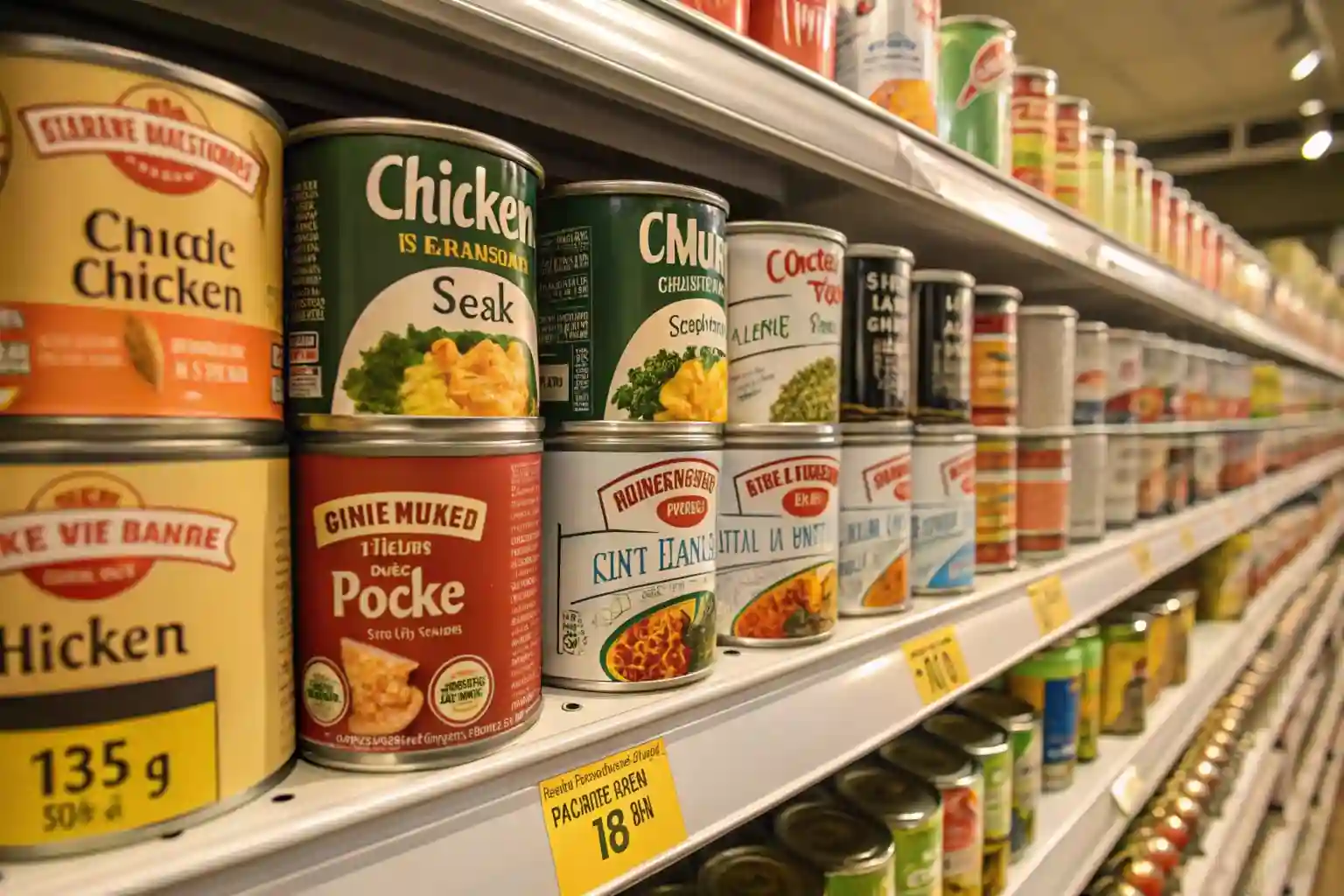Table of Contents
1. Introduction
Canned chicken has become a staple in many households due to its convenience and long shelf life. As busy lifestyles demand quick meal solutions, many people turn to canned chicken as a reliable source of protein. However, questions about its health implications often arise. Is canned chicken a healthy choice? In this article, we will explore the nutritional aspects of canned chicken, debunk common myths, and reveal the facts you need to make informed dietary choices.
2. Is Canned Chicken Highly Processed?
When discussing the healthiness of any food, it’s essential to understand whether it is processed.
- Definition of Processed Foods: Processed foods are those that have been altered from their original form for safety reasons or convenience. This includes methods like canning, freezing, and drying.
- Comparison of Canned Chicken to Fresh Chicken:
- Canned chicken is typically cooked during the canning process, which can make it more convenient but may also alter its nutritional profile.
- Fresh chicken, on the other hand, is often considered healthier due to its lack of preservatives and additives.
- Discussion on Preservatives and Additives:
- Many brands of canned chicken contain preservatives to enhance shelf life. Common additives include sodium and other flavor enhancers.
- High sodium content can be a concern, especially for individuals monitoring their salt intake. It’s crucial to read labels and choose options with lower sodium levels.
Key Takeaways:
- Canned chicken is processed but can still be a healthy option if chosen wisely.
- Always check the ingredient list for preservatives and sodium content.
3. Is Canned Chicken as Healthy as Fresh?

The debate between canned chicken and fresh chicken often centers around nutritional value.
- Nutritional Comparison:
- Canned chicken generally contains similar amounts of protein as fresh chicken, making it a good source of this essential nutrient.
- However, the nutritional value can vary significantly between brands. Some may add extra sodium or preservatives that can detract from its health benefits.
- Benefits of Canned Chicken:
- Convenience: Canned chicken is ready to eat, making it an excellent option for quick meals.
- Shelf-Stability: It can be stored for long periods without refrigeration, making it a practical choice for emergency supplies or busy days.
- Potential Downsides:
- Sodium Content: Many canned chicken products are high in sodium, which can lead to health issues if consumed in excess.
- Lack of Freshness: The flavor and texture of canned chicken may not match that of fresh chicken, which can affect meal satisfaction.
Key Takeaways:
- Canned chicken can be a healthy alternative to fresh chicken, but it’s essential to consider the nutritional differences.
- Opt for low-sodium varieties to maximize health benefits.
4. What is the Healthiest Canned Meat?
When considering canned meats, it’s essential to evaluate which options are the healthiest. While canned chicken is popular, there are various other canned meats available, each with its own nutritional profile.
Overview of Various Canned Meats
- Canned Tuna:
- A widely consumed canned meat, canned tuna is rich in omega-3 fatty acids, which are beneficial for heart health.
- However, it’s important to be aware of mercury levels, especially in larger species like albacore tuna. Opting for light tuna can reduce mercury exposure.
- Canned Salmon:
- Another excellent option, canned salmon is high in omega-3s and also provides vitamin D and calcium (if the bones are included).
- It’s a great alternative for those looking for a nutrient-dense canned meat.
- Canned Turkey:
- Similar to canned chicken, canned turkey is a lean protein source. It often contains fewer calories and fat than other canned meats.
- Look for options with minimal additives for the healthiest choice.
Nutritional Profiles of Different Options
- Canned Chicken:
- Typically contains about 20-25 grams of protein per serving, depending on the brand.
- Sodium levels can vary widely, so it’s crucial to check labels.
- Canned Tuna:
- Offers around 20-25 grams of protein per serving, with varying fat content based on whether it’s packed in oil or water.
- Sodium content can also be high, especially in flavored varieties.
- Canned Salmon:
- Provides about 22 grams of protein per serving and is rich in healthy fats.
- The presence of bones adds calcium, making it a nutrient-rich option.
Recommendations for Choosing Healthier Canned Meats
- Read Labels: Always check the nutrition facts and ingredient list. Look for options with lower sodium and fewer preservatives.
- Opt for BPA-Free Cans: Some canned products are packaged in BPA-free cans, which can reduce exposure to harmful chemicals.
- Consider Sustainability: Choose brands that prioritize sustainable fishing practices, especially for tuna and salmon.
Key Takeaways:
- Canned meats can vary significantly in nutritional value.
- Canned salmon and tuna are excellent alternatives to canned chicken, offering unique health benefits.
5. Should I Rinse Canned Chicken?

A common question among consumers is whether rinsing canned chicken is necessary or beneficial.
Benefits of Rinsing
- Reducing Sodium:
- Rinsing canned chicken can help remove some of the sodium that is often added during the canning process. This is particularly beneficial for those on a low-sodium diet.
- Improving Flavor:
- Rinsing can also help eliminate any metallic taste from the can, enhancing the overall flavor of the chicken.
When to Rinse and When It Might Not Be Necessary
- When to Rinse:
- If you’re concerned about sodium intake or if the canned chicken has a strong, unappealing flavor, rinsing is a good option.
- When It Might Not Be Necessary:
- If you’re using the chicken in a recipe where additional seasoning will be added, rinsing may not be necessary. The flavors can blend well during cooking.
Tips for Rinsing Canned Chicken Effectively
- Use a Colander:
- Pour the contents of the can into a colander and rinse under cold water for about 30 seconds. This will help remove excess sodium and any unwanted flavors.
- Pat Dry:
- After rinsing, pat the chicken dry with a paper towel to remove excess moisture before using it in your recipes.
Key Takeaways:
- Rinsing canned chicken can reduce sodium and improve flavor.
- Use a colander for effective rinsing and pat dry before cooking.
6. Is Canned Chicken Good to Eat Out of the Can?
Many people wonder if it’s safe and healthy to eat canned chicken straight from the can.
Safety Considerations for Eating Canned Chicken Directly
- Fully Cooked:
- Most canned chicken is fully cooked during the canning process, making it safe to eat straight from the can. However, it’s always best to check the label for specific instructions.
- Storage Conditions:
- Ensure that the can is intact and has been stored properly. Avoid consuming canned chicken from damaged or bulging cans, as this can indicate spoilage.
Nutritional Aspects of Consuming It Straight from the Can
- Protein Source:
- Eating canned chicken directly provides a quick source of protein, making it a convenient option for busy days.
- Sodium Content:
- Be mindful of the sodium content, as consuming it straight from the can may lead to higher sodium intake if you’re not rinsing it first.
Suggestions for Enhancing Flavor and Nutrition
- Add Seasonings:
- If eating straight from the can, consider adding herbs, spices, or a squeeze of lemon to enhance the flavor.
- Mix with Other Ingredients:
- Combine canned chicken with vegetables, whole grains, or legumes for a more balanced meal. This can help improve the overall nutritional profile.
Key Takeaways:
- Canned chicken is safe to eat directly from the can, but check for proper storage and can integrity.
- Enhance flavor and nutrition by adding seasonings or mixing with other ingredients.
7. Conclusion
In summary, canned chicken can be a convenient and nutritious option for those seeking quick meal solutions. While it is processed, it offers several benefits, including a good source of protein and long shelf life. However, it’s essential to be mindful of the sodium content and the presence of preservatives.
Key Points to Remember:
- Nutritional Value: Canned chicken provides similar protein levels to fresh chicken but may contain added sodium and preservatives.
- Healthier Alternatives: Consider other canned meats like tuna and salmon, which offer unique health benefits.
- Rinsing: Rinsing canned chicken can help reduce sodium and improve flavor, making it a better choice for those monitoring their salt intake.
- Safety: Canned chicken is safe to eat directly from the can, but always check for proper storage and can integrity.
For those interested in exploring more about healthy eating, you might find the article on Is Indian Food Healthy? insightful, as it discusses various cuisines and their health implications. Additionally, if you’re looking for other convenient meal options, check out Healthy Choice Frozen Meals, which can complement your busy lifestyle. Lastly, for a delicious way to use canned chicken, try the Healthy Buffalo Chicken Dip recipe, which is both tasty and nutritious.
By understanding the nutritional aspects and making informed choices, you can incorporate canned chicken into a balanced diet effectively.
8. FAQs
Is canned chicken highly processed?
Yes, canned chicken is considered a processed food because it undergoes cooking and preservation methods. However, it can still be a healthy option if you choose varieties with lower sodium and fewer additives.
Is canned chicken as healthy as fresh?
While canned chicken can provide similar protein levels to fresh chicken, it may contain added sodium and preservatives. Fresh chicken is often considered healthier due to its lack of additives, but canned chicken offers convenience and shelf stability.
What is the healthiest canned meat?
Canned salmon and tuna are often regarded as some of the healthiest canned meats due to their high omega-3 fatty acid content. Canned chicken is also a good option, but it’s essential to check for lower sodium varieties.
Should I rinse canned chicken?
Rinsing canned chicken can help reduce sodium content and improve flavor. It’s a good practice, especially if you’re concerned about salt intake.
Is canned chicken good to eat out of the can?
Yes, canned chicken is safe to eat directly from the can, as it is fully cooked during the canning process. However, ensure the can is intact and has been stored properly.
Is canned chicken cooked or raw?
Canned chicken is fully cooked during the canning process, making it safe to eat without further cooking. However, you can heat it if you prefer it warm or want to incorporate it into recipes.

